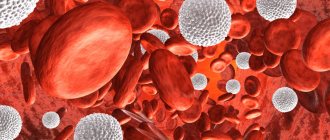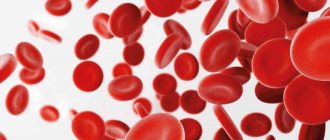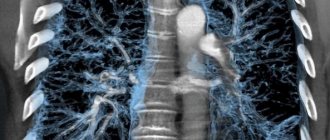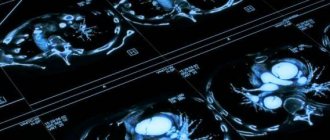Published: 03/30/2021 17:00:00 Updated: 03/30/2021
Erythrocytes are red blood cells, the most numerous blood cells. Formally, they are not cells, since during the process of maturation they lose many of the structures necessary for cells. For example, they lack nuclei and do not synthesize any protein molecules, unlike other cells in the body. So the name “cell” in this case is used for convenience. Red blood cells are formed in the bone marrow and constantly circulate in the body, performing the most important function of maintaining life - they carry oxygen from the lungs to tissues and organs and remove carbon dioxide.
In addition to red blood cells, blood contains plasma, platelets, and leukocytes. However, the number of red blood cells is so large that just a couple of drops of blood contains about one billion of these cells. They make up about 40% of the total blood volume. Actually, it is red blood cells that give our blood its characteristic red color due to its hemoglobin content.
Red blood cells do not last forever, they wear out over time and eventually die. The average life cycle of a red blood cell is approximately 120 days—a total of four months. However, do not worry, the bone marrow is constantly producing new cells and maintaining the required level of red blood cells. Various unfavorable circumstances can reduce or, conversely, increase their reproduction rate and affect their life expectancy - thus, the balance of blood composition is disrupted. An increase or decrease in red blood cells is associated with various pathological conditions. Let's consider this issue in more detail.
The first microscope and red blood cells
The content of the article
At that time, many people in Holland were engaged in grinding optical glasses to make lenses. Leeuwenhoek also became interested in grinding, and achieved high skill in this matter. Its small short-focus biconvex lenses, inserted into a miniature frame of its own design, gave a magnification of 300 times and a very clear image.
With the help of this simple device, three centuries ago A. Leeuwenhoek was able to see red blood cells - erythrocytes, which perform its most important function - supplying tissues with oxygen, a function without which life is impossible.
Many microscopes made by Leeuwenhoek's hands have survived to this day. Although they are not at all similar to modern microscopes, nevertheless, with their help he not only examined red blood cells, but also formed a correct idea of their size.
Important facts about red blood cells
Red blood cells (from the Greek words erythros - red and kytos - cell) make up the bulk of blood. There are 4.6-5.5 million of them per cubic millimeter in men and 4-5 million in women. And in 5-6 liters of blood circulating in the body of an adult, there are approximately 25 trillion red blood cells!
Unlike other cells, the red blood cell does not have a nucleus; its entire volume is filled with hemoglobin - a red protein, a special respiratory pigment. This protein has the amazing ability to easily combine with oxygen, turning into oxyhemoglobin.
The connection occurs in the pulmonary capillaries, where red blood cells come into contact with the air we inhale. Oxygen-enriched scarlet blood flows from the lungs to the heart, and from there through the arteries to all organs and tissues. Having quickly given them oxygen, hemoglobin also quickly combines with carbon dioxide, forming carboxyhemoglobin.
In the lungs, red blood cells give off carbon dioxide (it is removed from the body during exhalation) and again take oxygen into the lungs. In one day, an adult’s red blood cells carry about 800 liters of oxygen and 200 liters of carbon dioxide.
The shape of the red blood cell - in the form of a biconcave disk - provides a relatively large surface for contact of hemoglobin with gases. It is curious that the total surface of red blood cells is about three thousand square meters, that is, one and a half thousand times more than the surface of our body.
What work do red blood cells do?
The functions of red blood cells are diverse and extremely important for the functioning of the body:
- Red blood cells ensure tissue respiration. About 97% of the total mass of a red blood cell is hemoglobin. This substance contains a protein structure - a large molecule - globin, the second part is extra-protein, carrying positively charged iron - heme. Passing through the lungs, the blood is enriched with oxygen precisely due to hemoglobin, the ionic structure of which forms a weak bond with the oxygen molecule. In the tissues, hemoglobin leaves the gas necessary for breathing, replacing it with already exhausted carbon dioxide, and carries it back to the pulmonary alveoli. Oxygen-rich blood is called arterial, it has a rich scarlet color, blood transported from the tissues to the lungs is venous, dark red in color.
- For nutrients and active biological components, red blood cells act as a carrier, delivering them to the cells. The erythrocytes transport waste products through the venous blood to the liver for disposal and to the kidneys for excretion, thus performing the function of nutrition and cleansing.
- On their membranes, red blood cells have markers that determine a person's blood type. This is the most important indicator if blood transfusion is necessary. Because if incompatible blood enters the bloodstream, red blood cells stick together. Three-quarters of the world's population has another equally important blood indicator on the membrane of red blood cells - Rh protein.
- The removal of carbon dioxide by hemoglobin allows you to reduce the level of acidity in the body, thereby maintaining pH balance and acting as a regulator.
Functions of red blood cells
Norms of red blood cells
The normal hemoglobin content is 13-18 grams per 100 milliliters of blood, on average about 16. When the necessary tests are carried out in laboratories, this ratio is taken as 100 percent. As a rule, women have less hemoglobin than men, and obese people have more than thin people.
A decrease in the number of red blood cells or a decrease in the hemoglobin content in them leads to oxygen starvation. It happens, for example, to a person who has climbed high into the mountains without special training. He develops the so-called “mountain sickness”: breathing increases sharply, headaches, a feeling of fatigue and a feeling similar to intoxication appear - with nausea, dizziness, and vomiting.
About ten days is enough to acclimatize at an altitude of, say, 4,500 meters. During this time, the body begins to intensively produce red blood cells, and the content of hemoglobin in them increases, and, consequently, the ability of the blood to carry oxygen increases.
This happens not only during acclimatization. Examinations of athletes have shown that in long-distance runners, skiers, cyclists, and rowers, the body's ability to absorb oxygen can double or more. Blood parameters also change accordingly: its volume increases, the number of red blood cells and hemoglobin level increases.
Reasons for deviation from the norm
Factors that may lead to a decrease in the number of red blood cells:
- the formation of anemia in the body;
- insufficient intake of protein and vitamins from food;
- pathologies of the hematopoietic system;
- increased death of cellular elements due to exposure to toxic substances.
Reasons that cause an increase in the level of red blood cells in the blood:
- decreased fluid levels in the body;
- the occurrence of insufficiency in the respiratory and cardiovascular systems;
- pathological disorders in the hematopoietic system.
The main step when detecting changes in the number of red blood cells is to establish the pathology that led to this. To do this, it is recommended to undergo a comprehensive examination.
Composition of red blood cells
Over the past two decades, scientists have made particularly great strides in the study of red blood cells. It was possible to determine the structure of the hemoglobin molecule. Not only have all 150 amino acids that make up this molecule been determined, but their location has also been precisely determined.
These data shed light on the cause of a dangerous congenital disease - sickle cell anemia, common in Mediterranean countries. It turned out that this serious illness is caused by the replacement of one of the amino acids in the hemoglobin molecule.
It was also discovered that the deficiency of just one enzyme in the red blood cell leads to intolerance to certain foods and drugs. The results of research at the molecular level expand the possibilities of treatment and prevention of many serious diseases.
Hemoglobin concentration in blood
Hemoglobin (denoted as Hb) is a complex compound whose molecule is formed from heme and globin. Hemoglobin consists of 4 chains of amino acids with heme groups attached to each of them, having an iron atom (Fe) in the center.
Hemoglobin is contained in red blood cells, is their main component and is responsible for the function of carrying oxygen in blood (red blood cells). There are 4 types of globin subunits of hemoglobin - alpha, beta, gamma, delta.
Hemoglobin, in turn, is divided into three types, differing in physical properties and amino acid composition of the protein: HbA1 (which consists of alpha and beta globin chains - HbA1 accounts for 96-98% of all hemoglobin), HbA2 (which consists of alpha and delta globin chains, its content in the blood is about 2-3%), HbF (consisting of alpha and gamma globin chains, 1-2%). An interesting fact is that hemoglobin HbF dominates in the blood of a newborn; by 3 months of age, HbA appears in the blood and by 6 months the concentration of HbF smoothly decreases to 10%, giving way to HbA (in adults, HbF is in a concentration of no more than 2% ).

Hemoglobin
With hemoglobinopathy, cases of changes in hemoglobin forms are recorded, which appears due to a violation of the mechanism of synthesis of globin protein chains, for example thalassemia and S-hemoglobinopathy - sickle cell anemia.
Low hemoglobin is a rather serious symptom; this condition is called anemia. Many different factors lead to the development of anemia, including vitamin B deficiency, iron deficiency, and folic acid deficiency. Blood loss in acute and chronic forms also leads to anemia. A decrease in hemoglobin concentration leads to a lack of oxygen supply to the body's organs due to a disruption in the oxygen transfer function of red blood cells. Severe anemia is characterized by a decrease in hemoglobin concentration below 50 g/l and requires prompt blood transfusion to the patient.
Reference values (normal) hemoglobin concentrations for women and men are presented in the following table.
Table of hemoglobin norms in blood:
| Age | Women, g/l | Men, g/l |
| Blood from the umbilical cord | 135-200 | 135-200 |
| 1−3 days | 145-225 | 145-225 |
| 1 Week | 135-215 | 135-215 |
| 2 week | 125-205 | 125-205 |
| 1 month | 100-180 | 100-180 |
| 2 months | 90-140 | 90-140 |
| 3−6 months | 95-135 | 95-135 |
| 0.5−2 years | 106-148 | 114-144 |
| 3−6 years | 102-142 | 104-140 |
| 7−12 years | 112-146 | 110-146 |
| 13−16 years old | 112-152 | 118-164 |
| 17−19 years old | 112-148 | 120-168 |
| 20−29 years | 110-152 | 130-172 |
| 30−39 years | 112-150 | 126-172 |
| 40−49 years | 112-152 | 128-172 |
| 50−59 years | 112-152 | 124-172 |
| 60−65 years | 114-154 | 122-168 |
| Over 65 years | 110-156 | 122-168 |
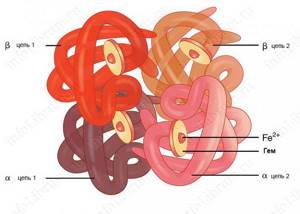
Hemoglobin
- Change in hemoglobin concentration in the blood
- Increased hemoglobin is recorded with: erythremia, erythrocytosis, dehydration, excessive physical exertion, smoking;
- Reduced hemoglobin is recorded in: anemia, overhydration.
Death of red blood cells
Red blood cells are produced continuously throughout a person's life in the bone marrow of the sternum, pelvic bones and in the long tubular bones of the arms and legs. The process of red blood cell maturation has been well studied. Its duration is 3-4 days. During this time, relatively large bone marrow cells with a large nucleus, containing almost no hemoglobin, multiply through a series of successive divisions. Gradually losing their nucleus, they decrease in size, hemoglobin is synthesized in them, and they turn into red blood cells.
But in the process of their life, red blood cells “wear out”. They live no more than 100-120 days, and then are destroyed and removed from the blood by the cells of the spleen and liver. Every day a person loses an average of 115 million red blood cells per minute. To replace them, the bone marrow produces new ones at the same pace.
Red blood cells, first discovered by Leeuwenhoek, have many remarkable properties. One of them cannot be kept silent about. Factors that determine the group properties of blood were discovered in erythrocytes.
Diagnosis of ESR
For diagnosing diseases, important indicators are: the number of red blood cells, reticulocytes, hemoglobin level and ESR (erythrocyte sedimentation rate). Immature reticulocyte cells in the general bloodstream should account for no more than 2% of the number of red blood cells. An increase in their number indicates increased hematopoiesis during bleeding, hypoxia, and anemia. Thus, the bone marrow tries to avoid oxygen starvation.
The average level of hemoglobin in the blood of men is 140 g/l, and 130 g/l in women. A decrease in the concentration of this protein can occur with a lack of iron, but it also often indicates the accelerated destruction of red blood cells. Therefore, it is extremely important to find out the reason for the decline. ESR is an indicator of the weight of erythrocyte cells and the rate of their precipitation.
The weighting of red blood cells occurs due to the adhesion of proteins involved in the body's immune defense to them. That is, the stronger the immune response to an established infection, the greater the amount of protein in the blood, and the correspondingly increased ESR. This study provides information about the presence of an inflammatory process in the body.
Indicators of the ESR norm also depend on the age, gender and condition of the person. In women, the erythrocyte sedimentation rate is higher compared to men, since they have fewer red blood cells; during pregnancy and monthly cycles, these numbers increase significantly. ESR in older people deviates significantly upward.
To maintain the required level of red blood cells in the blood, it is important for a healthy person to eat right, move actively and spend at least two hours in the fresh air every day.
Blood groups
There are four main blood groups. It turned out that the red cells of people of different blood groups differ in the presence or absence of special proteins in these cells - agglutinogens (antigens), designated by the Latin letters A and B.
Some lack antigens A and B (group 1, “universal” donor), others’ erythrocytes contain only antigen A (group II), others contain only antigen B (group III), and others contain both A and B (group IV , “universal” recipient).
Thus, the blood of not all groups is compatible. And if a person is transfused with blood of an incompatible group, a serious complication will occur - sticking (agglutination) of red blood cells, and then their destruction (hemolysis).
Ideally compatible for the recipient (the person receiving the transfusion) is blood of the same group. But if necessary, you can also use the blood of a “universal” donor. A “universal” recipient can practically receive a blood transfusion of any type.
Treatment
Therapy to reduce the number of red blood cells consists of eliminating the provoking factor. If the increase in red blood cells is caused by diseases of organs and systems, then the underlying disease must be treated first.
In case of erythrocytosis with hypoxic phenomena, therapy is carried out with the use of oxygen; in advanced situations with blood thickening, blood thinning drugs may be prescribed to avoid the formation of blood clots.
Bloodletting is considered a quick and effective method. After the procedure, patients are given glucose and blood replacement solutions. This method should be used with caution in people with heart defects and chronic obstructive pulmonary disease.
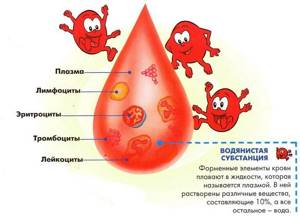
Attention!
When bleeding, the weekly blood volume should not exceed 200 ml with a hematocrit of at least 50%.
When smoking, the main recommendation is to quit the bad habit. Also, with erythrocytosis, a strict diet is prescribed, especially for obese patients. It is recommended to consume mainly dairy and vegetable dishes, an increased amount of liquid (water, herbal infusions, compotes), and limit foods rich in iron. Vitamin complexes are prohibited for use.
Blood transfusion and storage
Blood transfusion became possible thanks to the discovery of its group properties. Millions of donors regularly donate blood without any harm to their health. Securely packaged and stored in special bottles, it is delivered to all medical institutions in our country.
The problem of preservation and long-term storage of blood was successfully solved, and they learned how to prepare and use plasma and serum. They are convenient because when transfusing them, you do not need to take into account the compatibility of groups. Scientists have found the opportunity to preserve red blood cells under special conditions, which do not lose their precious properties for years.
Blood transfusion, a humane and powerful means of restoring human health, has become very widespread. The blood of donors brings salvation to people.
Three hundred years ago, A. Leeuwenhoek took the first step in studying blood, which in ancient times was considered a symbol of life. Over the next centuries, scientists around the world devoted a lot of effort and energy to putting life-giving medicine into the hands of doctors - donated blood.
ONLINE REGISTRATION at the DIANA clinic
You can sign up by calling the toll-free phone number 8-800-707-15-60 or filling out the contact form. In this case, we will contact you ourselves.
If you find an error, please select a piece of text and press Ctrl+Enter
Causes of increased red blood cells and types of erythrocytosis
There are quite a few varieties of this pathology, due to the reasons that caused it. Moreover, they can be both natural and pathological, posing a serious threat to human health and life. Depending on the causes, there are several classifications of pathology.
Relative erythrocytosis
With it, the number of red blood cells directly remains unchanged; their increase per unit volume of blood occurs due to a decrease in its plasma. The reasons for this are:
- dehydration;
- hypertensive crisis;
- large blood loss;
- burns;
- obesity;
- prolonged physical activity, stress;
- being in mountainous areas with thin air.
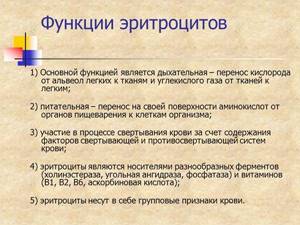
True erythrocytosis
Characterized by excessive production of red blood cells in the bone marrow. It can be of the following types, depending on the cause:
- Primary, or hereditary, is a rare phenomenon caused by difficulty in the exchange of oxygen by red blood cells and increased synthesis of erythropoietin due to a genetic factor. This is compensated by increased erythropoiesis, and asthenia, dizziness may be present, and the skin and mucous membranes may become purple in color.
- Secondary (absolute), or acquired – associated with various pathologies of organs and systems. This type of erythrocytosis is caused by oxygen starvation (hypoxia) of organs, as well as hormonal dysfunction, in particular increased production of erythropoietin. In this case, the causes of pathology may be:
- exposure to carbon monoxide (smoking, hazardous production), drinking poor-quality water;
- insufficiency of digestive enzymes for digesting food, vitamin deficiency.
- respiratory diseases, Pickwick syndrome, accompanied by significant obesity, respiratory failure and high blood pressure;
- Erythremia (Vaquez disease) is a rare pathology of the bone marrow of a tumor nature. In this case, erythrocytosis can be combined with leuko- and thrombocytosis;
- heart failure, vascular pathologies;
- heart defects - in this case, the increase in red blood cells is due to the mixing of venous and arterial blood in the cavity of the heart, which complicates the process of gas exchange;
- acute infectious diseases (diphtheria, whooping cough contribute to blockage of the respiratory tract);
- primary pulmonary hypertension (Aerz's disease);
- kidney disease (hydronephrosis, hypernephroma, cyst);
- oncological diseases (kidney cancer, pituitary adenoma, cerebellar hemangioblastoma, hepatoma, pheochromocytoma).
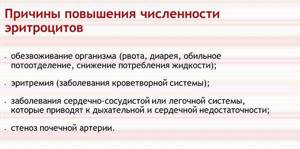
Reference!
An important clinical symptom in this case is the predominance of mature forms of red blood cells in the blood (due to the cessation of recycling of old cells by the liver and kidneys), while in other pathologies (respiratory, cardiac, infectious) the growth is due to young reticular forms.
